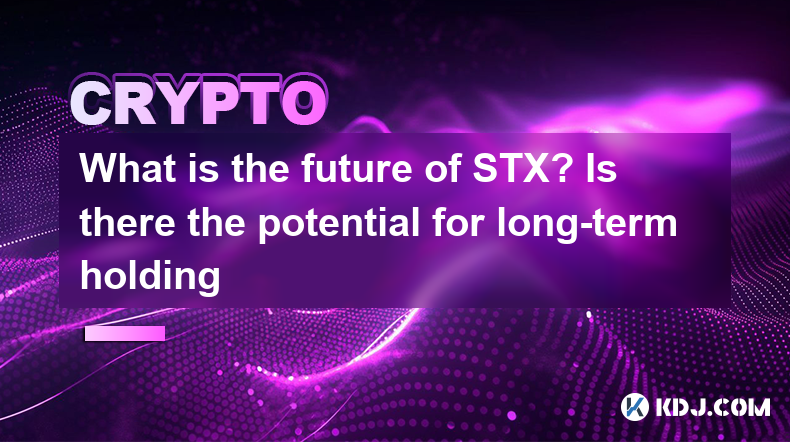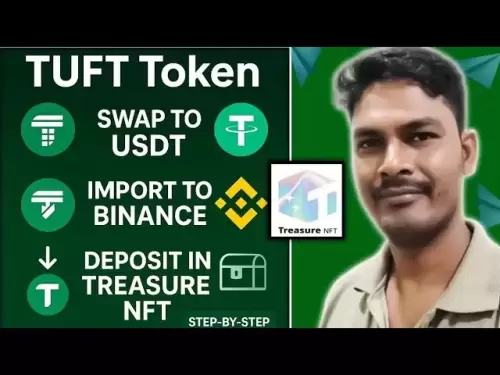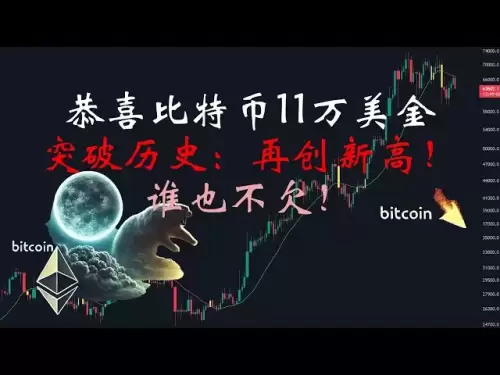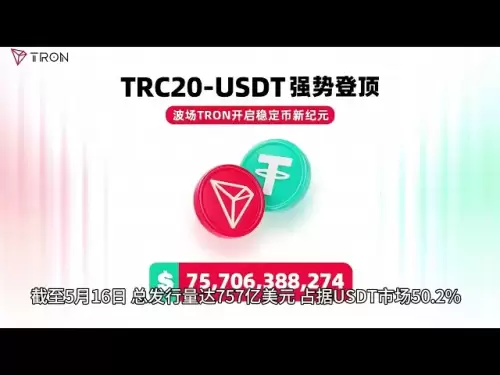-
 Bitcoin
Bitcoin $111,249.0355
1.95% -
 Ethereum
Ethereum $2,645.0010
1.93% -
 Tether USDt
Tether USDt $1.0001
-0.03% -
 XRP
XRP $2.4207
0.18% -
 BNB
BNB $680.2206
1.52% -
 Solana
Solana $178.2595
2.73% -
 USDC
USDC $0.9998
-0.01% -
 Dogecoin
Dogecoin $0.2396
1.83% -
 Cardano
Cardano $0.8015
3.15% -
 TRON
TRON $0.2764
1.26% -
 Sui
Sui $3.8688
-3.72% -
 Chainlink
Chainlink $16.7201
2.60% -
 Hyperliquid
Hyperliquid $32.7933
17.49% -
 Avalanche
Avalanche $25.1763
7.01% -
 Stellar
Stellar $0.3006
1.46% -
 Shiba Inu
Shiba Inu $0.0...01524
1.70% -
 Bitcoin Cash
Bitcoin Cash $435.6946
6.31% -
 Hedera
Hedera $0.2031
1.25% -
 UNUS SED LEO
UNUS SED LEO $8.8661
0.63% -
 Toncoin
Toncoin $3.1515
0.94% -
 Polkadot
Polkadot $4.9197
1.69% -
 Litecoin
Litecoin $98.8746
1.26% -
 Monero
Monero $397.3091
7.21% -
 Bitget Token
Bitget Token $5.2163
-0.58% -
 Pepe
Pepe $0.0...01425
-0.51% -
 Pi
Pi $0.8168
-1.17% -
 Dai
Dai $0.9998
0.02% -
 Ethena USDe
Ethena USDe $1.0006
-0.02% -
 Bittensor
Bittensor $473.5789
7.20% -
 Uniswap
Uniswap $6.4100
0.62%
What is the future of STX? Is there the potential for long-term holding
By integrating with the Bitcoin network, Stacks (STX) unlocks novel possibilities for DeFi, NFT management, and smart contract development, shaping its future prospects and long-term holding potential.
Feb 05, 2025 at 07:13 pm

Key Points:
- Understanding the Stacks (STX) blockchain and its unique features
- Exploring the potential applications of STX within the cryptocurrency ecosystem
- Analyzing the factors shaping the future prospects and long-term holding potential of STX
- Identifying the potential risks and challenges associated with investing in STX
What is Stacks (STX)?
Stacks (STX) is a layer-one blockchain that seamlessly integrates with the Bitcoin network. This unique architecture enables developers to build smart contracts and decentralized applications (dApps) that leverage the security and decentralization of Bitcoin. STX tokens serve as the native currency of the Stacks blockchain and are used for gas fees, staking, and governance.
Potential Applications of STX
The integration with Bitcoin opens up a wide range of potential applications for STX. These include:
- DeFi on Bitcoin: STX enables the development of decentralized finance (DeFi) applications that operate on the Bitcoin blockchain, offering a more secure and scalable alternative to existing solutions.
- NFT Integration: Stacks can be utilized to create and manage NFTs that are tied to Bitcoin addresses, providing unique ownership and provenance for digital assets.
- Smart Contract Development: Developers can harness the capabilities of smart contracts on the Stacks blockchain, leveraging the stability and security of Bitcoin's underlying infrastructure.
Factors Shaping the Future Prospects of STX
Several factors will influence the future prospects of STX:
- Blockchain Adoption: The wider adoption of the Stacks blockchain and its features will drive demand for STX tokens.
- DeFi Market Growth: The growth of the DeFi market and the increasing demand for on-chain financial services will benefit STX.
- Cryptocurrency Market Sentiment: The overall market sentiment towards cryptocurrencies will impact the price and demand for STX.
- Regulatory Landscape: Changes in the regulatory landscape for cryptocurrencies could affect the future of STX and its potential applications.
Long-Term Holding Potential of STX
The long-term holding potential of STX depends on several factors:
- Network Effects: As the Stacks network grows and adoption increases, the value of STX will likely escalate.
- Technological Advancements: Continued advancements in blockchain technology and the wider adoption of DeFi could enhance the long-term value of STX.
- Staking Incentives: Staking STX tokens provides rewards and contributes to network security, incentivizing long-term holding.
- Volatility: The cryptocurrency market is known for its volatility, which can affect the short-term price fluctuations of STX.
Potential Risks and Challenges
Before investing in STX, it's crucial to consider potential risks and challenges:
- Competition: Stacks faces competition from other layer-one blockchains vying for market share within the DeFi ecosystem.
- Regulatory Uncertainty: Regulatory changes could have a negative impact on the Stacks blockchain and its applications.
- Security Vulnerabilities: Any security vulnerabilities or vulnerabilities within the STX blockchain or its dApps could impact the value of the tokens.
FAQs:
- What is the purpose of the STX token?
STX is the native currency of the Stacks blockchain, used for gas fees, staking, and governance. - Is STX a good investment?
The investment potential of STX depends on market sentiment, DeFi market growth, regulatory changes, and technological advancements. - Is it possible to stake STX?
Yes, STX tokens can be staked to earn rewards and contribute to network security. - What is the potential value of STX?
The future value of STX will depend on market demand, network growth, and the broader adoption of DeFi and blockchain technology. - Are there any risks associated with investing in STX?
Potential risks include competition, regulatory uncertainty, and security vulnerabilities.
Disclaimer:info@kdj.com
The information provided is not trading advice. kdj.com does not assume any responsibility for any investments made based on the information provided in this article. Cryptocurrencies are highly volatile and it is highly recommended that you invest with caution after thorough research!
If you believe that the content used on this website infringes your copyright, please contact us immediately (info@kdj.com) and we will delete it promptly.
- The U.S. Mint Will Stop Making Pennies Early Next Year
- 2025-05-23 00:30:13
- LCX Lists Kaspa (what)
- 2025-05-23 00:30:13
- Pepe (PEPE) Price Shows Signs of a Potential Rally to a New Multi-month High at $0.000023793
- 2025-05-23 00:25:13
- Justin Sun Is the Top Holder of TRUMP Memecoin, His Solana Wallet Address Credited with Making the Purchase
- 2025-05-23 00:25:13
- Comparing the Potential of Polkadot (DOT) and Ozak AI (OZ) as the Year 2025 Continues
- 2025-05-23 00:20:13
- Pepe (PEPE) Price Prediction: On the Verge of a Strong Bullish Breakout as Whale Accumulation Continues
- 2025-05-23 00:20:13
Related knowledge

What is Ethereum’s Slashing mechanism and how to punish malicious behavior?
Feb 20,2025 at 03:08am
Key PointsOverview of slashingDifferent types of slashing in EthereumIncentives and consequences of slashingIdentifying and reporting slashed validatorsOngoing discussions and potential improvementsEthereum's Slashing Mechanism: Punishing Malicious BehaviorEthereum's slashing mechanism is an essential tool for ensuring network security and punishing mal...

What is the verifier node of Ethereum and how to become a verifier?
Feb 19,2025 at 06:00pm
The Verifier Node of Ethereum: A Comprehensive GuideKey Points:What is a Verifier Node?How to Become a Verifier NodeResponsibilities and Rewards of a Verifier NodeMinimum Requirements for Becoming a Verifier NodePotential Difficulties in Running a Verifier Node1. What is a Verifier Node?A Verifier Node is an independent entity on the Ethereum network th...

What is Ethereum’s staking, and how to participate and earn money?
Feb 19,2025 at 04:37pm
Key Points:Understanding Ethereum's Staking MechanismSteps to Participate in StakingBenefits and Rewards of StakingSecurity and Risk ConsiderationsTechnical Requirements and Hardware OptionsPotential Challenges and Troubleshooting TipsFAQs on Ethereum StakingWhat is Ethereum's Staking?Proof-of-Stake (PoS) is a consensus mechanism used in blockchain netw...

What is Ethereum’s DAO (Decentralized Autonomous Organization) and how does it work?
Feb 20,2025 at 03:12am
Key PointsDefinition and Structure of a DAOGovernance and Decision-Making in DAOsBenefits and Use Cases of DAOsChallenges and Limitations of DAOsWhat is Ethereum's DAO (Decentralized Autonomous Organization) and How Does It Work?Definition and Structure of a DAOA Decentralized Autonomous Organization (DAO) is an innovative governance and management fram...

What is Ethereum's multi-signature wallet and how to improve security?
Feb 20,2025 at 02:18pm
Key Points:Understanding the Concept of a Multi-Signature WalletBenefits and Drawbacks of Multisig WalletsRequirements for Setting Up a Multisig WalletStep-by-Step Guide to Generating a Multisig WalletImplementing Strategies for Enhanced Security1. Understanding the Concept of a Multi-Signature WalletA multi-signature (multisig) wallet in the Ethereum e...

What is Ethereum's oracle and how to provide data for smart contracts?
Feb 21,2025 at 01:30am
Key Points:Understanding the concept of oracles in EthereumExploring different types of oraclesDetailed guide on how to provide data for smart contractsAddressing potential challenges and considerationsWhat is Ethereum's Oracle?Oracles are crucial components in the Ethereum ecosystem, enabling smart contracts to access real-world data and off-chain even...

What is Ethereum’s Slashing mechanism and how to punish malicious behavior?
Feb 20,2025 at 03:08am
Key PointsOverview of slashingDifferent types of slashing in EthereumIncentives and consequences of slashingIdentifying and reporting slashed validatorsOngoing discussions and potential improvementsEthereum's Slashing Mechanism: Punishing Malicious BehaviorEthereum's slashing mechanism is an essential tool for ensuring network security and punishing mal...

What is the verifier node of Ethereum and how to become a verifier?
Feb 19,2025 at 06:00pm
The Verifier Node of Ethereum: A Comprehensive GuideKey Points:What is a Verifier Node?How to Become a Verifier NodeResponsibilities and Rewards of a Verifier NodeMinimum Requirements for Becoming a Verifier NodePotential Difficulties in Running a Verifier Node1. What is a Verifier Node?A Verifier Node is an independent entity on the Ethereum network th...

What is Ethereum’s staking, and how to participate and earn money?
Feb 19,2025 at 04:37pm
Key Points:Understanding Ethereum's Staking MechanismSteps to Participate in StakingBenefits and Rewards of StakingSecurity and Risk ConsiderationsTechnical Requirements and Hardware OptionsPotential Challenges and Troubleshooting TipsFAQs on Ethereum StakingWhat is Ethereum's Staking?Proof-of-Stake (PoS) is a consensus mechanism used in blockchain netw...

What is Ethereum’s DAO (Decentralized Autonomous Organization) and how does it work?
Feb 20,2025 at 03:12am
Key PointsDefinition and Structure of a DAOGovernance and Decision-Making in DAOsBenefits and Use Cases of DAOsChallenges and Limitations of DAOsWhat is Ethereum's DAO (Decentralized Autonomous Organization) and How Does It Work?Definition and Structure of a DAOA Decentralized Autonomous Organization (DAO) is an innovative governance and management fram...

What is Ethereum's multi-signature wallet and how to improve security?
Feb 20,2025 at 02:18pm
Key Points:Understanding the Concept of a Multi-Signature WalletBenefits and Drawbacks of Multisig WalletsRequirements for Setting Up a Multisig WalletStep-by-Step Guide to Generating a Multisig WalletImplementing Strategies for Enhanced Security1. Understanding the Concept of a Multi-Signature WalletA multi-signature (multisig) wallet in the Ethereum e...

What is Ethereum's oracle and how to provide data for smart contracts?
Feb 21,2025 at 01:30am
Key Points:Understanding the concept of oracles in EthereumExploring different types of oraclesDetailed guide on how to provide data for smart contractsAddressing potential challenges and considerationsWhat is Ethereum's Oracle?Oracles are crucial components in the Ethereum ecosystem, enabling smart contracts to access real-world data and off-chain even...
See all articles
























































































